This spring, archaeological excavations began at the historical-cultural site "Parz-Depe." The main goal was to study the stratigraphy of the cultural layers of the monument to determine the periods of habitation and gather information about the economic and cultural connections of the population with other regional sites. Excavations were conducted from the highest point of the monument to untouched substrate, covering a significant time span in the development of "Parz-Depe" culture.

For precise analysis of the layers and cultural strata, a previously studied pit measuring 4x4 meters was cleared in the southeastern part of the inner citadel. Excavations continued to the 16th layer, reaching a total depth of 8.5 meters. Research began at the 12th layer, where ceramic shards typical of the Eneolithic period were found. Further investigation revealed walls crossing the 13th layer, measuring 48 cm in height and 28 cm in width. These walls indicate a unified age for layers 12 and 13, supported by large cattle bones and pot fragments found within them, suggesting they belong to the late Eneolithic period.


In the 14th layer, a two-chamber hearth was discovered, measuring 100 x 77 cm, with walls preserved at a height of 20-21 cm from the floor level. The hearth was used for a long time, with its walls frequently renewed and plastered. The inner wall was made from clay and small ceramic fragments without pebbles, indicating advanced hearth-making techniques. The outer sides showed signs of fire exposure, indicating active use. In its southeastern part, remains of a child with a necklace were found, suggesting a ritual burial.

Three Eneolithic pots damaged by fire were found at the 15th layer beneath the hearth. One pot featured triangular figures resembling river waves and was bordered by twelve lines, significant for studying early art. The pots have been restored to their original form and are planned for transfer to the Historical and Local Museum of Arkadag city since "Parz-Depe" is within its territory.


At the 16th layer's stratigraphy, numerous items were found, including ceramic fragments, small cattle bones, and a copper item shaped like a miniature spoon measuring 8 x 11 cm. A chemical analysis determined the metal composition. This level also contained clay wall and vessel fragments from the early Eneolithic period. Walls found here were below the two-chamber hearth's floor level from the 15th layer, belonging to a lower construction horizon.

In conclusion, ceramics discovered in "Parz-Depe" layers demonstrate evolving production technology and artistic design from layers 12 to 16. Ceramic items from various periods show continuous improvement, highlighting "Parz-Depe's" role in regional pottery development. Eneolithic patterns like triangles and wavy lines reflect artistic and cultural traditions of that era.


Excavations also revealed that during the period of habitation at "Parz-Depe," new structures were built on old buildings serving as foundations for new constructions. This process led to forming a thick cultural layer and creating a mound where settlements existed. Discovered walls and pots under new buildings exemplify this continuity of habitation. Research at "Parz-Depe" continues.

Реджеп Джоммыев,
археолог, старший научный сотрудник Института истории и археологии Академии наук







